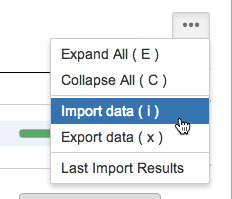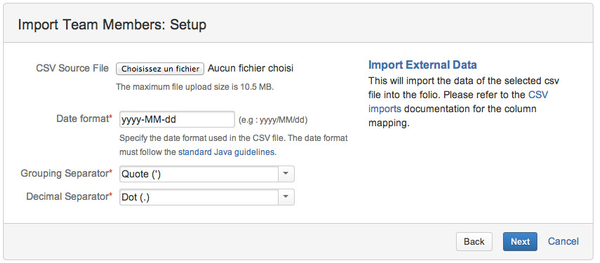This is the documentation for an older version of Folio and has been moved to the Tempo instance.
Please view the Folio Category in the Tempo Products Wiki Categories for all versions of Folio's Documentation.
Importing Data from CSV
The FOLIO importer allows you to import your data from a comma-separated value (CSV) file. CSV files are text files representing tabulated data and are supported by most applications that handle tabulated data (for e.g. Microsoft Excel, databases, etc.). The CSV import feature allows you to import issues from an external (issue tracking) system which:
The CSV import process consists of: Preparing your CSV fileThe FOLIO Importer assumes that your CSV file is based off a default Microsoft Excel-styled CSV file. Fields are separated by commas and any content that must be treated literally, such as commas and new lines/'carriage returns' themselves are enclosed in quotes.
CSV file requirementsIn addition to being 'well-formed', CSV files have the following requirements. Each CSV file must possess a heading row with a columns headerThe CSV file import wizard (below) uses a CSV file's header row to determine how to map data from the CSV file's 2nd row and beyond to fields in FOLIO. The header row should avoid containing any punctuation (apart from the commas separating each column) or the importer may not work correctly. Commas (as column/field separators) cannot be omittedFor example, this is valid:
Type, Name, Description, Amount, Category"Rent", "2231 Chiasson bvd", "This is a desc", 2,000.00, ,... but this is not valid:
Type, Name, Description, Amount"Rent", "2231 Chiasson bvd", "This is a desc", 2,000.00,
Encapsulating FOLIO data structure in your CSV fileCapturing data that spans multiple linesUse double-quote marks (
Type, Name, Description, Amount"Rent", "2231 Chiasson bvd", "This is ona new line", 2,000.00
Treating special characters literallyUse double-quote marks ( To treat a double quote mark literally, you can 'escape' them with another double quote mark character. Hence, the CSV value:
Running the CSV file import wizardBefore you begin: If your FOLIO installation has existing data — We strongly recommend that you Back up your existing FOLIO data by backing up your JIRA data.
Congratulations, you have successfully imported your CSV data into FOLIO! If you have any questions or encounter any problems, please contact FOLIO support. Folio section-specific CSV import
|


